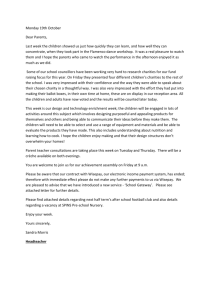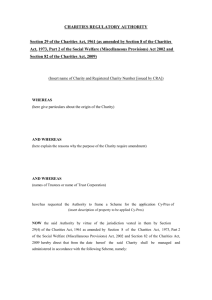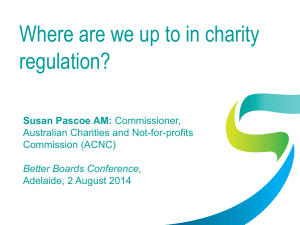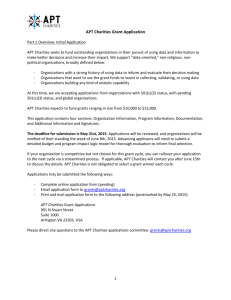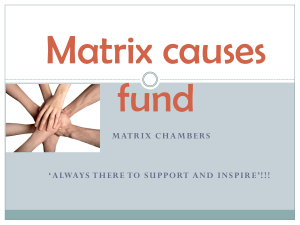Form 1: To be completed by Tier 1 charities
advertisement
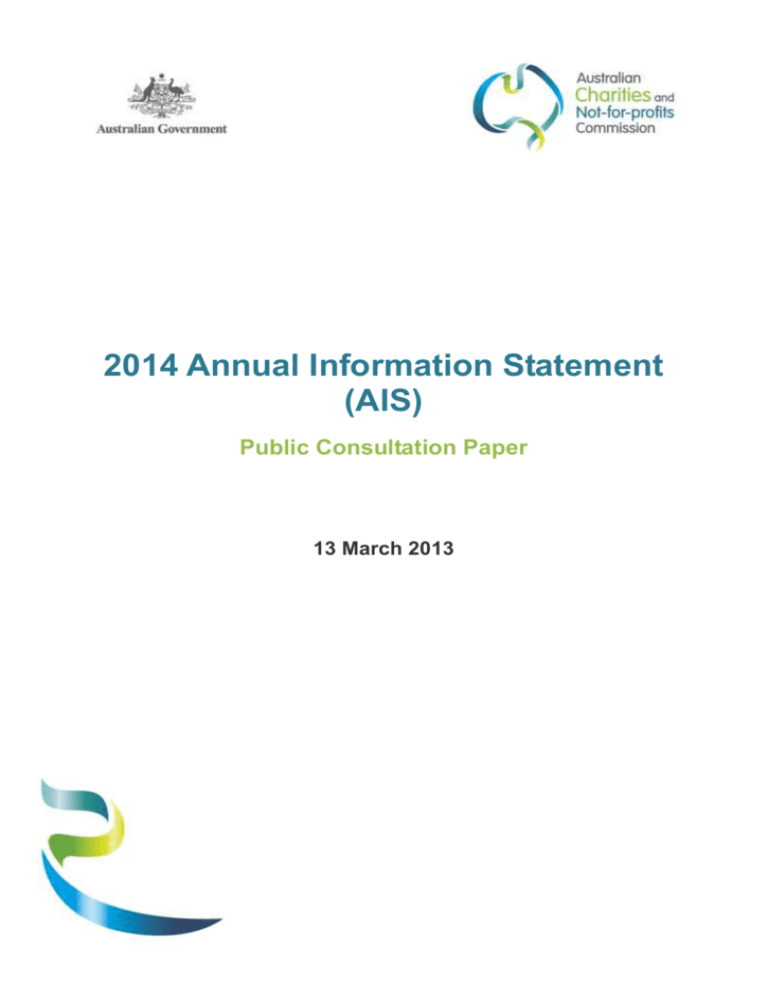
2014 Annual Information Statement (AIS) Public Consultation Paper 13 March 2013 CONTENTS A. INTRODUCTION - 3 Annual Information Statements (AIS) This consultation paper 3 6 B. 2014 ANNUAL INFORMATION STATEMENT – SMALL CHARITIES 7 C. 2014 ANNUAL INFORMATION STATEMENT – MEDIUM AND LARGE CHARITIES 8 D. CONSULTATION QUESTIONS 9 (i) (ii) (iii) (iv) (v) (vi) (vii) 9 10 11 11 12 13 13 E. Related party transactions Business activity Reserves Financial information collected for small charities Use of optional questions on the AIS ACNC assistance with financial reporting General comments ATTACHMENTS 16 (i) The proposed 2014 AIS additional questions for small charities (ii) The proposed 2014 AIS additional questions for medium and large charities (iii) The proposed guidance notes (iv) National Standard Chart of Accounts (NSCOA) 13 March 2013 2 A. INTRODUCTION Annual Information Statements 1. On 3 December 2012 the Australian Charities and Not-for-profits Commission (ACNC) became the new independent national regulator of charities. There are three objects in the Australian Charities and Not-for-profits Act 2012 (ACNC Act): (a) to maintain, protect and enhance public trust and confidence in the Australian not-for-profit sector; and (b) to support and sustain a robust, vibrant, independent and innovative Australian not-for-profit sector; and (c) to promote the reduction of unnecessary regulatory obligations on the Australian not-for-profit sector. 2. Registered charities will be required to report annually to the ACNC. Much of this information will be published on the ACNC register (to promote public trust and confidence) and provided to government agencies (to reduce regulatory and reporting obligations on charities). Every effort has been made to balance the task of collecting sufficient information to enable the ACNC to maintain public trust and confidence with its commitment to red tape reduction. 3. There are over 56 000 charities currently registered with the ACNC. For reporting periods (financial years) ending 30 June 2013 and onwards, all registered charities will have an obligation to submit an Annual Information Statement (AIS) to the ACNC within six months of the end of their reporting period. The ACNC does not charge fees for charities to submit reports to us. 4. Registered charities will only be required to provide non-financial information to the ACNC in their 2013 AIS.1 In 2014 and future years, registered charities will be required to provide financial and non-financial information to the ACNC in their annual AIS.2 Medium and large charities will also be required to provide their annual financial reports from 2014.3 1 The 2013 AIS applies to financial years ending on or after 30 June 2013 (but no later than 31 May 2014). Basic religious charities will not be required to provide financial information – refer to paragraph 13. 3 Registered charities can voluntarily lodge their financial reports or annual reports with the ACNC in 2013. Small charities will also be able to voluntarily lodge their financial reports or annual reports with the ACNC from 2014 onwards. 2 13 March 2013 3 5. From 2014, over 6 000 charities also registered with the Australian Securities and Investments Commission (ASIC) will complete this AIS and report to the ACNC instead of sending ASIC an annual statement and paying an annual ASIC review fee. 6. The Government of South Australia has announced that it will make changes to its incorporated associations and charitable collections legislation. When these changes are made, South Australian charitable incorporated associations will have their reporting requirements harmonised with ACNC requirements. If charities are registered with the ACNC and complete an AIS each year (and lodge annual financial reports if they are medium or large charities) they will also be able to collect donations in South Australia. More recently, the Australian Capital Territory (ACT) Government has also announced that charities incorporated as associations in the ACT will only need to report to the ACNC and not the ACT Office of Regulatory Services. Amendments will also be made to the Charitable Collections Act 2003 (ACT). 7. In most cases, the ACNC will publish the AIS for all registered charities and the annual financial reports lodged by medium and large charities on the ACNC Register. This will result in greater transparency and accountability for registered charities. In turn, this will help the ACNC to maintain, protect and enhance public trust and confidence in the Australian not-for-profit sector. By mid 2014 the public as well as registered charities will have easy access on the ACNC website to information provided in over 56 000 Annual Information Statements. 8. The ACNC will become the first credible source of information on all Australian registered charities. We plan to publish regular sector snapshots using AIS data. This will provide new insights into the contribution that registered charities make within Australia and internationally. 9. The ACNC is aware that for some charities the 2014 AIS represents the first time they will have been asked to report financial information to a regulator. We have been careful only to request financial information that we will use for our assessment activities, as required by the ACNC Act. Our assessment activities will ensure that we take a risk-based approach to compliance and that we provide education and assistance to the right charities at the right time. 10. We have developed guidelines to many of the questions in the AIS. We have also ensured that the financial information requested is consistent with the National Standard Chart of Accounts (NSCOA – see Attachment iv). This will go a long way towards helping registered charities understand the financial descriptions and it will 13 March 2013 4 mean data on the ACNC register will be consistent and able to be used by other agencies. Aligning our financial framework with NSCOA is a practical example of one way that the ACNC will help to reduce the regulatory burden for registered charities. 11. Government agencies will be able to access the AIS information and other information held by the ACNC through a ‘Charity Passport’. The Charity Passport will be used by the ACNC as a way of reducing reporting duplication for charities. It is a collection of information that government agencies recognise as accurate and use for identification and data exchange. The Charity Passport is not a paper document, but a way of electronically sharing and using information we collect from registered charities. One of the first examples of how this will benefit registered charities involves Commonwealth grants. From 1 June 2013, the revised Commonwealth Grant Guidelines4 state that departments must not seek information from grant applicants and grant recipients that is collected by other Commonwealth entities and is available to agency staff. In particular, departments must not request information provided to the ACNC. In addition, if a charity provides the ACNC with an independently audited financial statement, then a department should not require a financial acquittal, unless it has assessed the granting activity as higher risk. 12. Medium and large registered charities will be asked to record some of their financial information on the AIS, in addition to lodging their financial statements with the ACNC. Some of the financial information in the AIS may not be separately disclosed in the financial statements, for example the amount of grants and donations made outside Australia. Other financial information may be the same as in the financial statements. Asking charities to record this financial information in our AIS is the only way the ACNC will be able to deliver on the Charity Passport initiative, which will ultimately reduce reporting duplication for charities. Further, in the future it is intended that the ACNC will accept AIS data via Standard Business Reporting enabled software. For many registered charities this will make completing the AIS more efficient. 13. The ACNC Commissioner can approve a different AIS for different sizes of charities. In 2014, the ACNC will not ask small registered charities to provide as much information as medium and large registered charities. The ACNC Act classifies small, medium and large charities based on their annual revenue (calculated by reference to the accounting standards which apply at the time): 4 Paragraph 4.7 of the Commonwealth Grant Guidelines Second Edition http://www.finance.gov.au/publications/fmg-series/docs/FMG-3-Commonwealth-Grant-Guidelines-June2013.pdf 13 March 2013 5 small – annual revenue less than $250 000 medium – annual revenue of $250 000 or more and less than $1 million large – annual revenue of $1 million or more. 14. If a charity fits within the definition of a ‘basic religious charity’ (as defined in the ACNC Act 5) it is not required to provide annual financial reports. It must complete the same AIS as all other charities in 2013, but will not be required to answer financial questions in 2014 or future years. This consultation paper 15. Over the past 15 months the former Australian Charities and Not-for-profits Commission Taskforce and the ACNC consulted on, and have finalised, the content of the 2013 AIS. This consultation paper seeks feedback on the additional questions and financial information that the ACNC proposes to collect in the 2014 AIS. The ACNC is very keen to hear from a wide range of charities and their representatives and advisors from across the country. Every effort will be made to accommodate your suggestions within the limitations of the requirements of the ACNC Act. 16. Please read this consultation paper in conjunction with the ACNC’s policy for Annual Information Statements, which provides a more comprehensive overview of the legislative background and objectives of the AIS. 17. The content of the 2014 AIS may also be influenced by the external conduct standards (which have not been released by Treasury for public comment at the time of preparing this paper), the financial reporting regulations and the governance standards (which were released by Treasury for public comment on 18 December 2012, with submissions closing 15 February 2013, but have not been finalised at the time of preparing this consultation paper). 5 A basic religious charity (BRC) is registered for a purpose that is the advancement of religion and cannot be registered as any other subtype. Amongst other things, BRCs are not a body corporate or an Indigenous corporation registered under particular legislation, or an incorporated association, they have not received more than $100,000 in government grants in the current financial year or either of the previous two financial years, and they are not endorsed as a deductible gift recipient (DGR) (however they can be endorsed to operate DGR funds, institutions or authorities as long as their total revenue is less than $250,000 for the particular financial year). 13 March 2013 6 18. Submissions are due by 5pm on Friday 26 April 2013. Submissions can be made using our online survey https://www.surveymonkey.com/s/ACNC_2014AIS or emailed directly to the ACNC at consultations@acnc.gov.au. Alternatively post your submission to us at: Reporting and Red Tape Reduction Directorate Australian Charities and Not-for-profits Commission GPO Box 5108 Melbourne Vic 3001. B. 2014 ANNUAL INFORMATION STATEMENT – SMALL CHARITIES Additional questions proposed in the 2014 AIS for small charities 19. The 2014 AIS will contain two additional questions for small registered charities. Attachment (i) sets out the proposed questions and draft guidance notes. They cover: (i) (ii) the use of cash or accrual accounting, and business activity. 20. The purpose of asking about cash or accrual accounting is to identify how charities have calculated revenue and expense totals in their AIS. 21. The purpose of asking about business activity is to identify the nature of the charity’s activities. More information about this topic is in consultation section D, below. Financial information proposed in the 2014 AIS for small charities 22. The 2014 AIS will request basic financial information for small registered charities. This information (along with the NSCOA references) is outlined in Attachment (i) and (iv). The information requested is: (i) (ii) (iii) (iv) (v) total income/receipts (with a breakdown of government grants and donations/bequests if applicable) total expenses (with a breakdown of employee expenses/payments if applicable) grants and donations made within Australia (if applicable) grants and donations made outside Australia (if applicable) total assets 13 March 2013 7 (vi) total liabilities. 23. The purpose of these questions is to help the ACNC conduct assessment activities to do with entitlement to registration and compliance with the ACNC Act. They will also enable the Australian Taxation Office (ATO) to conduct assessment activities that relate to taxation law. 24. The ACNC is interested in your feedback on whether any additional information should be collected by small charities and reported on, or if some of the above information should not be collected from small charities. Refer to consultation section D, below, for more information. C. 2014 ANNUAL INFORMATION STATEMENT – MEDIUM AND LARGE CHARITIES Additional questions proposed in the 2014 AIS for medium and large charities 25. The 2014 AIS will contain additional questions for medium and large registered charities. Attachment (i) sets out the proposed questions and draft guidance notes. They cover: (i) (ii) (iii) (iv) the preparation of general purpose or special purpose financial statements whether the audit or review report was modified and if so, how related party transactions (see part D, below, for explanation), and business activity. 26. The purpose of asking a question about general or special purpose financial statements is to identify whether the charity’s financial statements comply with all relevant Australian accounting standards. 27. The purpose of asking a question about audits and reviews is to identify whether the financial statements of medium sized charities have been subject to an audit or review and, in the case of both medium and large charities, the outcome of their audit or review. 28. The purpose of asking about related party transactions is to help the ACNC assess whether related parties may be obtaining private benefit. More information about this topic is in consultation section D, below. 29. The purpose of asking about business activity is to identify the nature of the charity’s activities. More information about this topic is in consultation section D, below. 13 March 2013 8 Financial information proposed in the 2014 AIS for medium and large charities 30. The 2014 AIS will request the same financial information for medium and large registered charities. This information should be consistent with information in the annual financial reports that charities must lodge with the ACNC (or another approved regulator, during the transitional period). 31. Attachments (ii) and (iv) set out the information requested, along with the NSCOA references. 32. The purpose of these questions is to help the ACNC conduct assessment activities to do with entitlement to registration and compliance with the ACNC Act. They will also enable the ATO to conduct assessment activities that relate to taxation law. D. CONSULTATION QUESTIONS Related party transactions (medium and large) 33. Financial statements and notes prepared by medium and large registered charities must give a true and fair view and, in most cases, comply with accounting standards. Accounting standard AASB 124 requires related party disclosures. The objective of accounting standard AASB 124 is: …to ensure that an entity’s financial statements contain the disclosures necessary to draw attention to the possibility that its financial position and profit or loss may have been affected by the existence for related parties and by transactions and outstanding balances with such parties. 34. The ACNC believes that disclosure of information about related party transactions involving registered charities is critical for our assessment activities. Transactions with related parties may impact on a charity’s entitlement to register. If these transactions are not at arm’s length, related parties could be obtaining private benefits. 35. Disclosing whether related party transactions exist will also increase the transparency and accountability of registered charities. 36. The ACNC proposes to require medium and large charities to indicate whether there have been related party transactions, as defined in AASB 124. 13 March 2013 9 1 Consultation question: related party transactions (medium and large) Do you agree that medium and large registered charities should separately disclose related party transactions in the AIS as proposed in Attachment (ii)? If not, what approach would you suggest and why? Business activity (small, medium and large) 37. A number of charities conduct some form of business activity. That is, some of their activities are carried out in the: - form of a business - nature of trade, or - form of a regular or continuous grant of a lease, licence or interest in property.6 38. In some instances this business activity may be directly related to charitable purposes. In other instances it may be commercial activity undertaken with the intention of reinvesting the majority of the business profit or surplus towards the fulfillment of charitable purposes. 39. Usually business activities involve some form of commercial risk. 40. The ACNC proposes to require small, medium and large charities to disclose whether they derive revenue from business activities and, if so, the type of business activities they undertake. We will not require charities to disclose specific financial information about their business activities. 41. The purpose of asking about business activities is to help the public understand the nature of activities conducted by a charity. This information will be used by the ACNC to assess whether the charity is a not-for-profit entity and whether there is a likelihood of private benefits. 2 6 Consultation question: Business activity (small, medium and large) Do you agree that small, medium and large charities should separately disclose information about their business activities as proposed in Attachment (i) and (ii)? If not, what approach would you suggest and why? This definition of business is also used for the Australian Business Register. 13 March 2013 10 Reserves (medium and large) 42. Annual financial reports of medium and large charities will generally include disclosure on the purpose of their reserves and any restrictions on the use of assets. 43. The Australian Accounting Standards Board Accounting Standard AASB 101 Presentation of Financial Statements states at paragraph 101.5: ‘If entities with not-for-profit activities in the private sector or the public sector apply this Standard, they may need to amend the descriptions used for particular line items in the financial statements and for the financial statements themselves.’ 44. Examples of the types of reserve categories for not-for-profit entities include general funds, designated funds, restricted funds, asset revaluation reserve and net unrealised gains reserve. 45. The ACNC proposes to require medium and large registered charities to disclose only three types of reserves in their AIS (if these reserves exist for the particular charity): the asset revaluation reserve, restricted purpose funds and other funds. This information will be used by the public and the ACNC to understand the extent and nature of accumulated funds available. It will also be used by the ACNC to assess compliance with governance standards, for example in relation to a charity’s ability to utilise funds to meet debts. 3 Consultation question: Reserves (medium and large) What information, if any, should medium and large charities be required to provide about reserves in the AIS? Why? Financial information collected for small charities 46. The ACNC proposes to require small charities to provide significantly less information in their 2014 AIS than medium and large charities. The proposal outlined in Attachment (i) contains two additional questions and basic financial information in respect of income/receipts, expense/payments, assets and liabilities. 47. Unlike medium and large charities, small charities are not required to lodge annual financial reports with the ACNC (however, they do have the option of lodging them voluntarily). 13 March 2013 11 48. Even though small charities will be asked to provide minimal financial information in the 2014 AIS, like all registered charities they must keep financial records. These records must allow them to explain the charity’s transactions, financial position and performance and they must enable true and fair financial statements to be prepared and to be audited. 49. As a concession, small charities will be permitted to report AIS financial information on a cash basis or an accruals basis. Cash based accounting is intended for use by small charities: (i) that are not required to use accrual accounting for the financial year under their governing documents (ii) that do not currently have any corporate or financial reporting obligations to use accrual accounting for the financial year for any Commonwealth department, or state or territory regulators and (iii) if their key personnel, with influence over the decision-making and planning of the charity, elect to use cash accounting when preparing accounting records. 4 Consultation question: Financial information collected for small charities Based on the current proposal in Attachment (iii) is there any additional financial information that you believe should be collected (or not collected) from small charities. Why? Use of optional questions on the AIS 50. The AIS could be expanded to include optional questions to collect information that specifically discharges the obligations of charities to report to state, territory and Commonwealth agencies. 51. If registered charities elected to answer these questions, they would have the advantage of not reporting separately to state, territory and Commonwealth agencies. For example, if their state or territory required specific financial information to be reported annually, under charitable collections legislation, this could be supplied via the ACNC’s AIS. 52. Charities that decide not to answer the optional questions on the AIS would continue to report the information directly to the state, territory or Commonwealth agencies on separate forms provided by those agencies. 13 March 2013 12 53. Over time, this approach could be used to help harmonise reporting requirements across states, territories and Commonwealth agencies. 5 Consultation question: Use of optional questions on the AIS (small, medium and large) Do you have any comments on the proposal to include optional financial questions in the AIS that charities can complete so they can meet any specific requirements of state, territory or Commonwealth agencies that also apply to them? ACNC Assistance with financial reporting 54. The ACNC recognises that for some charities, particularly smaller charities, it may be challenging to collect and report financial information for the first time. If you have suggestions about how the ACNC can assist your charity to understand and meet its financial reporting obligations, please let us know. Tell us what would work best for your charity. 6 Consultation question: ACNC assistance with financial reporting What types of practical assistance (if any) would you like to receive from the ACNC to help your charity meet its financial reporting obligations to us? When would you like to receive this assistance? General comments 55. The ACNC is interested to receive any general comments about the proposed additional AIS questions and financial information in this document. 7 Consultation question: General comments Are there any other comments you wish to make about the proposed additional questions or financial information in this consultation document? Please be specific. 13 March 2013 13 Summary 56. The following table summarises the consultation questions, discussed above. 1 Related party transactions (medium and large) Do you agree that medium and large registered charities should separately disclose related party transactions in the AIS as proposed in Attachment (ii)? If not, what approach would you suggest and why? 2 Business activity (small, medium and large) Do you agree that small, medium and large charities should separately disclose information about their business activities as proposed in Attachments (i) and (ii)? If not, what approach would you suggest and why? 3 Reserves (medium and large) What information, if any, should medium and large charities be required to provide about reserves in their AIS? Why? 4 Financial information (small) Based on the current proposal in Attachment (i) is there any additional financial information that you believe should be collected (or not collected) from small charities? Why? 5 Use of optional questions on the AIS (small, medium and large) Do you have any comments on the proposal to include optional financial questions in the AIS which charities can complete to meet any specific requirements of state, territory or Commonwealth agencies that apply to them? 6 ACNC assistance with financial reporting What types of practical assistance (if any) would you like to receive from the ACNC to help your charity meet its financial reporting obligations to us? When would you like to receive this assistance? 7 General comments (small, medium and large) Are there any other comments you wish to make about the proposed additional questions or financial information in this consultation document? Please be specific. 13 March 2013 14 E. ATTACHMENTS 57. The following items are attached: (i) The proposed 2014 AIS additional questions for small charities (ii) The proposed 2014 AIS additional questions for medium and large charities (iii) The proposed guidance notes (iv) National Standard Chart of Accounts (NSCOA) 13 March 2013 15 Attachment (i) The proposed 2014 AIS additional questions for small charities The following questions will be asked in 2014 in addition to the questions in the 2013 AIS. 1. Did your charity use cash or accrual accounting in the 2014 financial year? Answer options: Cash/Accrual/Did not report 2. Business activity: (i) In the 2014 financial year did your charity derive revenue from business activities? Answer options: Yes __ No ____ (ii) If you answered yes to question (i), what type of business activities did your charity undertake? The proposed financial information in the 2014 AIS for small charities Income Statement Income/Receipts 1 Total Income/Receipts (i) Commonwealth grants7 (ii) State/territory grants (iii) Local grants (iv) Donations and bequests $X $X $X $X $X Expenses/Payments 2 Total expenses/payments (i) Employee expenses/payments $X $X $X Net surplus/deficit after grants and donations made (i) Grants and donations made within Australia (ii) Grants and donations made outside Australia $X $X Balance Sheet Assets 3 Total assets $X Liabilities 4 Total liabilities $X $X Net Assets/Liabilities 7 We propose to ask for this detailed breakdown of grants so that we can distinguish Commonwealth grants, which will be subject to the new Commonwealth Grant Guidelines (see paragraph 11), from other government grants. Unless it is a high risk grant, the information we collect on the AIS will satisfy Commonwealth acquittal requirements. 13 March 2013 16 Attachment (ii) The proposed 2014 AIS additional questions for medium and large charities The following questions will be asked in 2014 in addition to the questions in the 2013 AIS. 1. Did your charity prepare general purpose or special purpose financial statements in the 2014 financial year? Answer options: General Purpose/Special Purpose 2. Audit/Review: (i) Were your charity's 2014 financial statements audited or reviewed? Answer options: Audited/Reviewed (ii) If your 2014 financial statements were audited or reviewed, did the auditor or reviewer modify their audit or review opinion? Answer options: Yes/No (iii) If you answered yes to question (ii), what was the reason for that modification? 3. Business activity: (i) In the 2014 financial year did your charity derive revenue from business activities? Answer options: Yes __ No ____ (ii) If you answered yes to question (i), what type of business activities did your charity undertake? 4. Related party transactions: (i) In the 2014 financial year did your charity have related party transactions as defined in AASB standard 124? Answer options: Yes / No 13 March 2013 17 Attachment (ii) (cont) The proposed financial information in the 2014 AIS for medium and large charities Income Statement Gross income 1 Government grants8 (i) Commonwealth grants (ii) State/territory grants (iii) Local grants 2 Other grants Total grants 3 Revenue from providing services and sale of goods 4 Donations and bequests 5 Other fundraising revenue 6 Investment revenue 7 All other revenue Total revenue 8 Net realised and unrealised gains Total Gross Income Expenses 9 Employee expenses (i) Salary sacrifice 10 Cost of providing services and sale of goods (excluding employee expenses) 11 Depreciation and amortisation 12 Interest and debt servicing costs 13 Net realised and unrealised losses 14 All other expenses Total expenses Net surplus/deficit before grants and donations made 15 Grants and donations made within Australia 16 Grants and donations made outside Australia Net surplus/deficit after grants and donations made 8 We propose to ask for this detailed breakdown of grants so that we can distinguish Commonwealth grants, which will be subject to the new Commonwealth Grant Guidelines (see paragraph 11), from other government grants. Unless it is a high risk grant, the information we collect on the AIS will satisfy Commonwealth acquittal requirements. 13 March 2013 18 Balance Sheet Assets Current assets 18 Cash and short term investments 19 Inventory 20 Other current assets Total current assets Non-current assets 21 Land and buildings (net of depreciation) 22 Long-term investments 23 Loans receivable 24 Other non-current assets Total non-current assets Total assets Liabilities 25 26 27 28 Current liabilities Current loans Other current liabilities Total current liabilities Non-current liabilities Non-current loans Other long term liabilities Total non-current liabilities Total liabilities Accumulated funds 29 Asset revaluation reserve 30 Restricted purpose funds 31 Other funds Total accumulated funds Total liabilities and accumulated funds 13 March 2013 19 Attachment (iii) The proposed additional question guidance notes in the 2014 AIS The following guidance notes will be provided for the 2014 questions which will be asked in addition to the questions in the 2013 AIS. Guidance notes: Cash/accrual accounting (small) - Cash reporting records transactions when money changes hands, either when it is received or paid out. Providing cash reports can include the preparation of very simple reports such as simple cash statements, copies of bank statements or bank reconciliations. However, it may also include complex cash based reports. – Accrual reporting recognises the effects of transactions and other events when they occur (and not when cash or its equivalent is received or paid). These transactions are recorded in the accounting records (and reported in the financial statements) of the periods to which they relate. - If your charity did not prepare any financial reports at all during the last financial year, tick the ‘did not report’ box. Guidance notes: Business activity (small, medium, large) - Your charity will be conducting business activities if some of its activities are carried out in the: - form of a business - nature of trade, or - form of a regular or continuous grant of a lease, licence or interest in property. For the purposes of this question, it does not matter if the business activity is directly related to charitable purposes or if it is not directly related to charitable purposes. We will use your response to this question to help us identify charities which have a charitable purpose and derive a portion of their income from business activities. This information is relevant to assess compliance with governance standards – for example, whether there has been responsible management of financial affairs. It is also relevant to assess whether your charity is a not-for-profit entity or whether the nature of the business activities indicate there may be private benefits. HELPFUL HINT: Your type of business activity may have been described when the charity applied for an ABN. You can also refer to business industry codes for a complete list of business activities. Guidance notes: General purpose / special purpose financial statements (medium, large) - If you prepare general purpose financial statements you will have applied all applicable accounting standards issued by the Australian Accounting Standards Board. The adoption of the reduced disclosure regime is considered to comply with the standards. - If you prepared financial statements but they did not meet the definition of general purpose financial statements, then they will be special purpose financial statements. 13 March 2013 20 HELPFUL HINT: If you ticked the ‘cash’ box in question (i) then your reports will be special purpose financial reports. Guidance notes: Audits and reviews (medium, large) - Under the ACNC Act, medium registered charities must have annual financial reports audited or reviewed and large registered charities must have annual financial reports audited. - An audit or review modification occurs when an auditor or reviewer indicates in their opinion that some aspect of the financial statements, the data used to create the financial statements, or the controls relied upon to ensure money, assets and transactions are identified and reported, are not reliable or appropriately reported. A modification may also occur where the auditor/reviewer believes the financial future of the organisation is at risk. - The purpose of asking this question is to identify in the AIS whether a medium charity’s financial statements have been subject to audit or review, and to identify for both medium and large charities the outcome of that audit or review. Guidance notes: Related party transactions (medium, large) When you answer this question, apply the definition of related party contained in AASB 124 Related Party Disclosures (December 2009) (paragraph 9).9 If you have prepared general purpose financial statements you will have applied this standard. A related party transaction is a transfer of resources, services or obligations between a registered charity and a related party, regardless of whether a price is charged. Some examples of such transactions are defined in paragraph 21 of AASB 124. Related party transactions include (this is not an exhaustive list): Purchases and sales of goods Purchase and sales of property and other assets Rendering or receiving of services Transfers under finance arrangements (including loans and equity contributions in cash or in kind). 9 Accounting standards are available at: http://www.aasb.gov.au/Pronouncements/Current-standards.aspx 13 March 2013 21 Attachment (iv): National Standard Chart of Accounts (NSCOA) Description Income statement NSCOA Gross income 1 Government grants Record grants from Commonwealth, state, territory and local governments. This will include operating and capital grants as well as recurrent and non-recurrent grants. Include contributions from governments, even if there is an obligation to supply some goods or services to the government. 4-1010 Grants (Commonwealth) Operating – Recurrent 4-1020 Grants (Commonwealth) Operating – Non-recurrent 4-1030 Grants (Commonwealth) – Capital (i) Commonwealth grants * Commonwealth government elements of 4-1100 - Grants - Other 4-3030 Contributions (Commonwealth government) of goods 4-1040 Grants (State) Operating – Recurrent 4-1050 Grants (State) Operating – Non-recurrent 4-1060 Grants (State) – Capital (ii) State/territory grants * State government elements of 4-1100 - Grants - Other 4-3030 Contributions (State government) of goods 4-1070 Grants (Local) Operating – Recurrent 4-1080 Grants (Local) Operating – Non recurrent 4-1090 Grants (Local) – Capital (iii) Local grants * Local government elements of 4-1100 - Grants - Other 4-3030 Contributions (local government) of goods 13 March 2013 1 Record grants from non-government organisations. Non-government elements of 4-1100 - Grants - Other Record revenue from the provision of charitable services and revenue from business activity. This will include fees, charges, membership fees and the sales of goods and services. 4-4020 Fees and Charges - Restricted 4-4030 Fees and Charges - Unrestricted 4-4040 Other Fees and Charges 4-4080 (NSW only) Membership Fees 4-4010 Sales 4 Donations and bequests Record donations and bequests received in both monetary and non-monetary form. 4-2010 Donations received 4-2020 Tax Deductible Donations (Non-public) 4-2030 Donations (Public collections) 4-2040 Non-tax deductible gifts 4-2050 Bequests 5 Other fundraising revenue Record revenue from gaming, sponsorship and licensing fees. 4-3010 Contributions (Members) 4-3020 Contributions (Public) 4-3040 Contributions (Philanthropic trusts and corporations) 4-3050 (NSW only) Contributions (Traders) 4-4050 Sponsorship and licensing fees 4-4060 Income from Gaming 4-4070 Sales of tickets 6 Investment revenue Record revenue from investments, for example interest, dividends and rental income. 4-5010 Interest - Restricted 4-5020 Interest - Unrestricted 4-5030 Rental income 4-5040 Dividends received 7 All other revenue Record all other revenue not previously captured. Other income may include: 2 Other Grants Total grants 3 Revenue from providing services and sale of goods 4-5035 Recoupments 4-5050 Other/Sundry Income 13 March 2013 2 4-0000 to 4-5060 Total revenue 8 Net realised and unrealised gains Record realised gains on the sale of non-current assets and all unrealised gains. 4-5060 Gain on Sale of Non-Current Assets 4-5050 Other/Sundry Income (relating to realised and unrealised gains) 4-0000 to 4-5060 Total Gross Income Expenses 9 Employee expenses Record all salaries and wages paid, leave expenses, termination payments, superannuation, workers’ compensation and other additional accounts relevant to the payment of salaries and wages (excluding salary sacrifice). 6-0601 S&W Annual Leave Expense 6-0602 S&W Fringe Benefits Tax 6-0603 S&W Long Service Leave Expense 6-0604 S&W Recruitment Expense 6-0605 S&W Salary Sacrifice 6-0606 S&W Sick Leave Expense 6-0607 S&W Superannuation 6-0608 S&W Termination Payments 6-0609 S&W Workers' Compensation 6-0610 S&W Salaries - Other 6-0611 S&W Salaries & Wages 6-0612 S&W Fees paid 6-0613 S&W Cost Recovery AND any other additional accounts that may be created by the charity under 6-0600 6-0605 S&W Salary Sacrifice (i) Salary sacrifice 10 Cost of providing services and sale of goods (excluding employee expenses) Record costs arising from the provision of services and the cost of goods sold. 6-0110 to 6-0200 Client Support Services (excludes salary and wages) 5-0000 to 5-0400 Cost of good sold 11 Depreciation and amortisation Record all depreciation expenses, including depreciation of property, plant, equipment and motor vehicles. 6-0250 Depreciation - Building 6-0260 Depreciation - Motor Vehicle 6-0270 Depreciation - Plant & Equipment 6-0280 Depreciation - Rental Properties 6-0290 Depreciation - Rental Properties Furniture & Fittings 13 March 2013 3 12 Interest and debt servicing costs Record all interest and debt servicing costs. 6-0445 Interest paid 13 Net realised and unrealised losses Record realised and unrealised losses. 6-0460 Loss on sale of assets 14 All other expenses Record all other expenses not previously captured. Other expenses may include: 6-0025 Agency Temp Staff 6-0030 Amortisation Expense 6-0040 Assets Purchased <$5,000 6-0060 Auspicing Fees 6-0070 Bank Charges 6-0080 Bad Debts 6-0085 Board/Governance 6-0100 Cleaning & Pest Control 6-0230 Consultancy Fees 6-0240 Credit Card Fees 6-0310 Employment Support and Supervision Costs 6-0315 Entertainment Costs 6-0320 Equipment Hire/Lease 6-0330 Fees & Permits 6-0340 to 6-0390 Fundraising and Gaming Expenses 10 6-0503 MV Insurance 6-0504 MV Registration 6-0505 MV Lease Payments 6-0506 MV Other 6-0530 Property Management Fees 6-0540 Publications and Information Resources 6-0550 Rates & Taxes 6-0560 Rates - Rental Properties 6-0570 Rent 10 Note NSCOA currently applies differing definitions for these accounts across the states and territories (for the purposes of the AIS these should all be mapped to other expenses). 13 March 2013 4 6-0580 Rent - Rental Properties 6-0590 Repairs & Maintenance 6-0595 Repairs & Maintenance - Rental Properties 6-0650 Security Expenses 6-0690 Tenancy and Property Supplies and Services 6-0700 Training & Development (Staff) 6-0710 Travel & Accommodation 6-0730 Volunteer Costs 6-0740 Write off Expenses 6-0000 to 6-0740 Total expenses Net surplus/deficit before grants and donations made 15 Grants and donations made within Australia Record all grants and donations made within Australia. 6-0300 Donations Paid (note: breakdown required to limit figure to national donations paid) 16 Grants and donations made outside Australia Record all grants and donations made outside Australia. 6-0300 Donations Paid (note: breakdown required to limit figure to international donations paid) 13 March 2013 5 Description Balance Sheet NSCOA Assets Current assets 1-1110 Cash at Bank - Restricted 1-1120 Cash at Bank - Unrestricted 1-1140 Petty Cash 1-1150 Cash Float 1-1160 Undeposited Funds 18 Cash and short term investments 19 Inventory Record the value of all inventory on hand. 1-1300 Inventory on Hand 20 Other current assets Record all other current assets not previously captured. 1-1180 Prepayments 1-1190 Accrued income 1-1200 Other financial assets 1-1210 Accounts receivable 1-1220 Less: Provision for Doubtful Debts 1-1230 Accounts Receivable - Rental Debtors 1-1240 Less: Provision for Doubtful Debts - Rental Debtors 1-1250 Other Debtors 1-1260 Less: Provision for Doubtful Debts - Other Debtors 1-1400 Other Current Assets 1-1500 ABN Withholding Credits 1-1170 Short-Term Investments 1-1100 Total current assets Non-Current Assets 21 Land and buildings (net of depreciation) Record the value of land and buildings, net of depreciation. 1-7100 Buildings 1-7110 Less: Accumulated Depreciation on Buildings 1-6000 Land 13 March 2013 6 22 Long-term investments Record the value of all long-term investments. 1-5100 Long-term investments 23 Loans receivable Record only those financial assets relating to loans receivable. 1-5150 Other Financial Assets 24 Other non-current assets Record all other non-current assets not previously captured. For fixed assets such as plant and equipment, motor vehicles and furniture and fittings, record the totals net of depreciation. Record intangibles net of amortisation. 1-5150 Other Financial Assets 1-5210 Accounts Receivable 1-5220 Less: Provision for Doubtful Debts 1-5230 Accounts Receivable - Rental Debtors 1-5240 Less: Provision for Doubtful Debts - Rental Debtors 1-5250 Other Debtors 1-5260 Less: Provision for Doubtful Debts - Other Debtors 1-7120 Plant and Equipment 1-7130 Less: Accumulated Depreciation on Plant and Equipment 1-7140 Rental Property Furniture & Fittings 1-7150 Less: Accumulated Depreciation - Rental Properties Furniture & Fittings 1-7160 Motor Vehicles 1-7170 Less: Accumulated Depreciation on Motor Vehicles 1-7180 Intangibles 1-7190 Less: Accumulated Amortisation on Intangibles 1-7200 Other Non-Current Assets Total non-current assets 1-5000 Total assets 1-0000 to 1-7200 Liabilities 2-0000 Current Liabilities 25 Current loans 26 Other current liabilities 2-1130 Loans Payable Record all other current liabilities not previously 2-1110 Accounts Payable 13 March 2013 7 captured. Total current liabilities Non-current liabilities 27 Non-current loans 28 Other long term liabilities 2-1120 Accrued Expenses 2-1140 Payables - Other 2-1150 GST Payable 2-1160 Less GST Receivable 2-1170 Employee Benefits/Employee Provisions 2-1175 ABN Withholding Tax Payable 2-1180 PAYG Withholding Payable 2-1190 Superannuation Payable 2-1200 Salary Sacrifice 2-1210 Hire Purchase Liability 2-1220 Lease Liability 2-1230 Revenue Received in Advance 2-1240 Grants Received in Advance 2-1250 Grants Repayable to Government Departments 2-1260 Other Current Liabilities 2-2230 Loans Payable Record other long term liabilities, such as hire purchase or lease liabilities, not previously captured. Total non-current liabilities Total liabilities 2-2210 Hire Purchase Liability 2-2220 Lease Liability 2-2240 Employee Benefits/ Employee Provisions 2-2250 Other Non-Current Liabilities 2-0000 to 2-2250 Accumulated Funds 3-3000 Asset Revaluation Reserve 29 Asset revaluation reserve 30 Restricted purpose funds Restricted funds are funds held that must be spent on a particular purpose of the charity. This includes funds that are temporarily restricted by donors for certain 3-4000 Other Reserves (in relation to restricted purpose funds) 13 March 2013 8 31 Other funds purposes and/or for future time periods and permanently restricted funds that are to be maintained in perpetuity. Record all other funds not previously captured. 3-4000 Other Reserves 3-0000 to 3-5000 Total accumulated funds Total liabilities and accumulated funds X 13 March 2013 9
